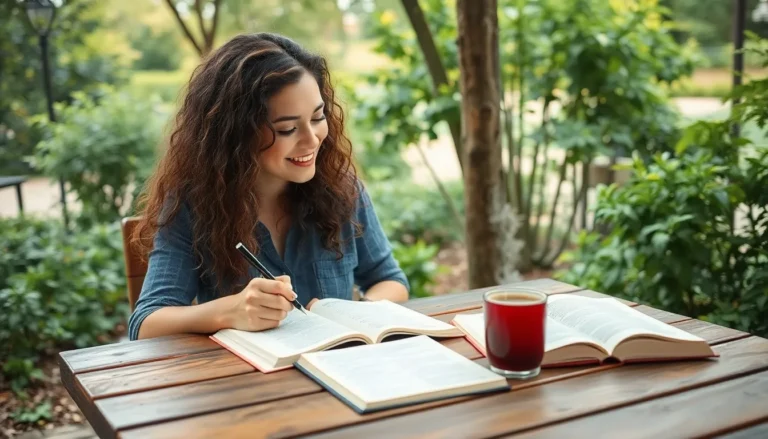Table of Contents
ToggleEver watched a video and thought, “Wow, that would be epic in slow motion!”? Well, it’s time to turn that thought into reality. With just a few taps on an iPhone, anyone can transform their ordinary footage into a cinematic masterpiece. Who knew that slowing down time could be so easy and free?
Understanding Slow Motion Videos
Slow motion videos create captivating visual experiences, allowing viewers to appreciate details often missed in real-time. This technique highlights movement, making action sequences appear more dramatic and artistic.
When editing a video, applying slow motion can alter the perception of speed, emphasizing certain moments or actions. It’s common for filmmakers to use this effect to draw attention to specific elements within a scene, such as a sports play or an emotional expression.
Tools available on the iPhone enable users to easily convert regular footage into slow motion after recording. Users can adjust the playback speed, often ranging from two to eight times slower than the original speed, depending on their creative vision.
Incorporating slow motion transforms the narrative, giving life to mundane footage. This technique can also enhance storytelling, making scenes more engaging and impactful.
Many specific settings in iPhone’s editing software allow for fine-tuning. Adjusting frames per second can lead to varied effects, impacting the smoothness of the slow motion. By showcasing intricate movements, users can evoke emotions that resonate with the audience.
Overall, understanding the art of slow motion is crucial. Creators can elevate their video content significantly when they master this technique, resulting in visually stunning and memorable presentations.
Step-by-Step Guide to Slow Motion on iPhone
Transforming videos to slow motion on an iPhone is straightforward. Follow these steps to enhance your footage.
Accessing the Photos App
Open the Photos app located on your iPhone’s home screen. Tap on the app icon to launch it. Navigate through the albums or library to find your videos. Look for the ‘Videos’ album, as it contains all recorded video files. Select the desired video by tapping on it, which opens the video viewer. This access point streamlines the editing process, making it efficient to begin adjustments.
Selecting Your Video
Once inside the Photos app, locate the video intended for slow-motion conversion. Thumbnails allow quick identification based on visual content. Tap on the video thumbnail to enter playback mode. Notice the editing options at the bottom of the screen, which appear once the video loads. Choose this video carefully to ensure it conveys the intended effect after slow-motion processing.
Editing Your Video
Tap the ‘Edit’ button on the upper right corner of the screen to access editing tools. Adjust playback speed by selecting the slow-motion feature. Locate this option within the editing interface, where it provides sliders for speed adjustments. Drag the slider to set the desired slow-motion effect, allowing fine-tuning based on scene requirements. After completing adjustments, tap ‘Done’ to save the updated video. This editing technique enhances visual storytelling, creating engaging footage.
Tips for Better Slow Motion Results
Achieving impressive slow-motion results involves attention to detail in both lighting and shot composition. Effective techniques enhance video quality and viewer engagement.
Lighting Considerations
Good lighting plays a crucial role in slow-motion videos. Natural light provides the best conditions, ensuring subjects appear clear and vibrant. When filming indoors, utilize bright artificial lighting to maintain visibility. Experimenting with different times of day can also help, as golden hour light produces soft, appealing shadows. Avoid harsh overhead lights that can create unflattering highlights. Finally, check for glare or reflections that may distract from the main subject.
Framing Your Shots
Framing affects the overall impact of slow-motion footage. Centering the subject adds focus and visual appeal. Use a variety of angles for a dynamic effect, such as low angles or close-ups that highlight details. Leaving some space around the subject offers room for movement, enhancing the slow-motion effect. Incorporate leading lines to guide viewers’ attention and create a more immersive experience. Finally, ensure that the background complements the subject without overpowering it.
Common Mistakes to Avoid
Using slow motion improperly can lead to disappointing results. First, neglecting proper lighting affects the final video quality. Insufficient light can result in grainy footage that distracts viewers. Second, overexcessive slow motion often diminishes the impact of the action. Employing a subtle slow-motion effect typically enhances storytelling rather than overwhelming it.
Ignoring composition also detracts from video appeal. Centring subjects within the frame produces clean, focused shots. Experimenting with angles can lead to more dynamic visuals. Choosing cluttered or distracting backgrounds might divert attention from the main subject.
Failing to plan shots can lead to missed opportunities for engaging content. Recording too quickly without considering movement and pacing impacts the effectiveness of slow motion. Reviewing each scene before recording helps capture the best moments.
Additionally, when editing, users sometimes forget to review playback speed settings. Altering speed inconsistently can confuse viewers regarding the intended effect. Saving videos with drastic changes might not reveal the desired impact.
Finally, losing sight of the story can render slow-motion effects meaningless. Each video should convey a clear message or emotion, enhancing the viewer’s experience. Focusing on these common pitfalls ensures that the slow-motion technique effectively contributes to video quality.
Creating slow-motion videos on an iPhone opens up a world of creative possibilities. With just a few taps users can elevate their footage and engage viewers in new ways. The ability to adjust playback speed and fine-tune settings allows for personalized results that can transform everyday moments into cinematic experiences.
By paying attention to lighting and composition users can further enhance their videos and avoid common pitfalls. Mastering these techniques not only improves video quality but also ensures that each piece of content effectively communicates its intended message. With practice and experimentation anyone can become proficient in crafting stunning slow-motion videos that captivate and resonate.




